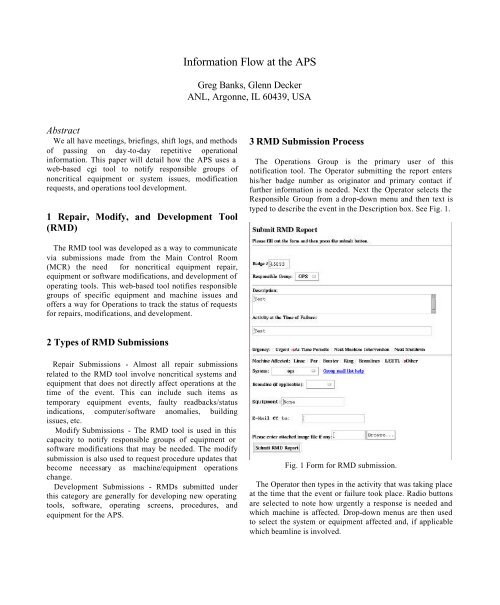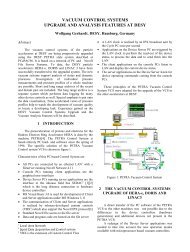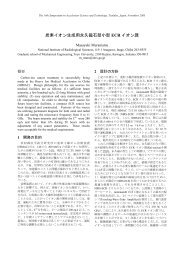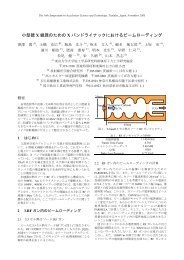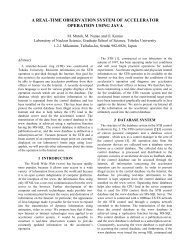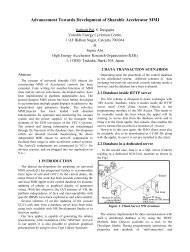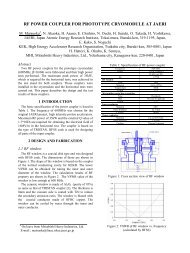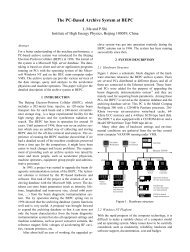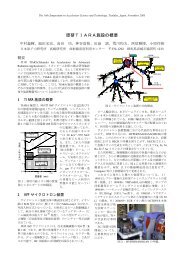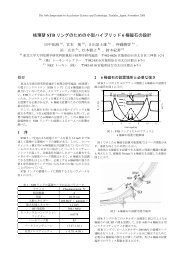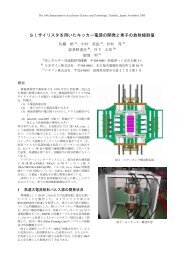Information Flow at the APS
Information Flow at the APS
Information Flow at the APS
You also want an ePaper? Increase the reach of your titles
YUMPU automatically turns print PDFs into web optimized ePapers that Google loves.
Abstract<br />
We all have meetings, briefings, shift logs, and methods<br />
of passing on day-to-day repetitive oper<strong>at</strong>ional<br />
inform<strong>at</strong>ion. This paper will detail how <strong>the</strong> <strong>APS</strong> uses a<br />
web-based cgi tool to notify responsible groups of<br />
noncritical equipment or system issues, modific<strong>at</strong>ion<br />
requests, and oper<strong>at</strong>ions tool development.<br />
1 Repair, Modify, and Development Tool<br />
(RMD)<br />
The RMD tool was developed as a way to communic<strong>at</strong>e<br />
via submissions made from <strong>the</strong> Main Control Room<br />
(MCR) <strong>the</strong> need for noncritical equipment repair,<br />
equipment or software modific<strong>at</strong>ions, and development of<br />
oper<strong>at</strong>ing tools. This web-based tool notifies responsible<br />
groups of specific equipment and machine issues and<br />
offers a way for Oper<strong>at</strong>ions to track <strong>the</strong> st<strong>at</strong>us of requests<br />
for repairs, modific<strong>at</strong>ions, and development.<br />
2 Types of RMD Submissions<br />
Repair Submissions - Almost all repair submissions<br />
rel<strong>at</strong>ed to <strong>the</strong> RMD tool involve noncritical systems and<br />
equipment th<strong>at</strong> does not directly affect oper<strong>at</strong>ions <strong>at</strong> <strong>the</strong><br />
time of <strong>the</strong> event. This can include such items as<br />
temporary equipment events, faulty readbacks/st<strong>at</strong>us<br />
indic<strong>at</strong>ions, computer/software anomalies, building<br />
issues, etc.<br />
Modify Submissions - The RMD tool is used in this<br />
capacity to notify responsible groups of equipment or<br />
software modific<strong>at</strong>ions th<strong>at</strong> may be needed. The modify<br />
submission is also used to request procedure upd<strong>at</strong>es th<strong>at</strong><br />
become necessary as machine/equipment oper<strong>at</strong>ions<br />
change.<br />
Development Submissions - RMDs submitted under<br />
this c<strong>at</strong>egory are generally for developing new oper<strong>at</strong>ing<br />
tools, software, oper<strong>at</strong>ing screens, procedures, and<br />
equipment for <strong>the</strong> <strong>APS</strong>.<br />
<strong>Inform<strong>at</strong>ion</strong> <strong>Flow</strong> <strong>at</strong> <strong>the</strong> <strong>APS</strong><br />
Greg Banks, Glenn Decker<br />
ANL, Argonne, IL 60439, USA<br />
3 RMD Submission Process<br />
The Oper<strong>at</strong>ions Group is <strong>the</strong> primary user of this<br />
notific<strong>at</strong>ion tool. The Oper<strong>at</strong>or submitting <strong>the</strong> report enters<br />
his/her badge number as origin<strong>at</strong>or and primary contact if<br />
fur<strong>the</strong>r inform<strong>at</strong>ion is needed. Next <strong>the</strong> Oper<strong>at</strong>or selects <strong>the</strong><br />
Responsible Group from a drop-down menu and <strong>the</strong>n text is<br />
typed to describe <strong>the</strong> event in <strong>the</strong> Description box. See Fig. 1.<br />
Fig. 1 Form for RMD submission.<br />
The Oper<strong>at</strong>or <strong>the</strong>n types in <strong>the</strong> activity th<strong>at</strong> was taking place<br />
<strong>at</strong> <strong>the</strong> time th<strong>at</strong> <strong>the</strong> event or failure took place. Radio buttons<br />
are selected to note how urgently a response is needed and<br />
which machine is affected. Drop-down menus are <strong>the</strong>n used<br />
to select <strong>the</strong> system or equipment affected and, if applicable<br />
which beamline is involved.
Additional equipment inform<strong>at</strong>ion can be in <strong>the</strong><br />
equipment text box to provide more details, and image<br />
files can be <strong>at</strong>tached to fur<strong>the</strong>r illustr<strong>at</strong>e <strong>the</strong> event th<strong>at</strong><br />
took place. Once all of <strong>the</strong> inform<strong>at</strong>ion is in place, <strong>the</strong><br />
Oper<strong>at</strong>or submits <strong>the</strong> report, which will be sent to selected<br />
members of <strong>the</strong> design<strong>at</strong>ed responsible group or via a<br />
group mailing list maintained by Oper<strong>at</strong>ions. Each<br />
submitted RMD is issued a report number and placed in a<br />
text file in order to monitor its st<strong>at</strong>us.<br />
4 RMD Response Process<br />
Once submitted, <strong>the</strong> responsible group and Oper<strong>at</strong>ions<br />
receive notific<strong>at</strong>ion of <strong>the</strong> RMD report via e-mail. A<br />
member of <strong>the</strong> responsible group is <strong>the</strong>n required to<br />
submit a response to <strong>the</strong> RMD describing <strong>the</strong> actions th<strong>at</strong><br />
<strong>the</strong>y will take to correct <strong>the</strong> item. In most cases <strong>the</strong><br />
corrective action can be performed <strong>the</strong> very next day.<br />
However, <strong>the</strong>re are times when <strong>the</strong> work needs to be<br />
delayed until <strong>the</strong> next period when User oper<strong>at</strong>ions are<br />
not taking place, e.g., machine studies period or scheduled<br />
maintenance period.<br />
The Oper<strong>at</strong>ions Group staff is primarily responsible for<br />
following up on all RMDs th<strong>at</strong> involve his/her area of<br />
responsibility. The RMD will remain current until some<br />
form of action has been taken or until a response has been<br />
issued. It is understood th<strong>at</strong> RMDs submitted for<br />
modific<strong>at</strong>ions or development may not be resolved right<br />
away, and <strong>the</strong> tool has proven itself to be a good way to track<br />
items th<strong>at</strong> are needed.<br />
After <strong>the</strong> work has been completed to correct problems<br />
reported in an RMD, <strong>the</strong> responsible group <strong>the</strong>n provides a<br />
response via e-mail noting th<strong>at</strong> <strong>the</strong> repair has taken place. The<br />
Oper<strong>at</strong>ions Chief of Oper<strong>at</strong>ions (CO) <strong>the</strong>n marks <strong>the</strong> RMD as<br />
completed and deletes it from <strong>the</strong> current records. All<br />
completed and deleted RMDs are kept in an archive for a<br />
period of two years. At <strong>the</strong> end of this period <strong>the</strong>y are<br />
removed from <strong>the</strong> system.<br />
5 Summary<br />
The RMD reporting system has proven itself to be a very<br />
beneficial inform<strong>at</strong>ion tool <strong>at</strong> <strong>the</strong> <strong>APS</strong>. It provides <strong>the</strong><br />
Oper<strong>at</strong>ions Group with a web-based notific<strong>at</strong>ion and tracking<br />
system for machine issues, modific<strong>at</strong>ion needs, and<br />
development ideas for all areas of <strong>the</strong> <strong>APS</strong>.<br />
6 Acknowledgement<br />
This work was supported by <strong>the</strong> U.S. Department of<br />
Energy, Office of Basic Energy Sciences, under Contract<br />
No. W-31-109-ENG-38.


